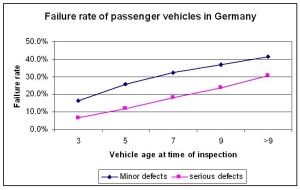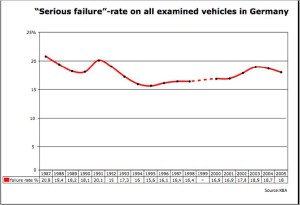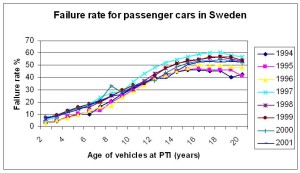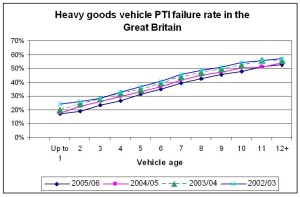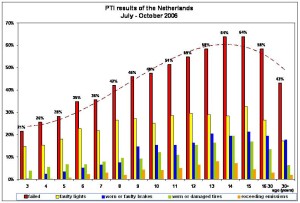Trends
Trends in the European Community
Introduction
In 2006-2007 CITA made a study for the European Commission (DGTREN) on Future Options for Roadworthiness Enforcement in the European Union (AUTOFORE). We looked for available evidence on roadworthiness conditions of in-service vehicles which are used on public roads.
All vehicles deteriorate whilst in service and studies from individual countries show similar overall trends. It is almost impossible to compile a detailed comparison due to the differences in inspection methods and pass/fail criteria, but defect levels have remained high over the years. Currently there are no systematic studies to cover a wider region, i.e. the European Community, but the European Commission is collecting and publishing data on roadside inspection results.
The currently available data show the following general TRENDS
The Average Defect Rate:
- Did not decrease significantly over the years
- Increases significantly with vehicle age
- Shows no signs of improving with the introduction of new technologies and manufacturing systems
Several statistics from a variety of countries illustrate these trends.
Periodical Technical Inspection – Germany
For 3 million passenger vehicles inspected in Germany in 2004, more than 10% of the vehicles that were 5 years old at the time of inspection, had serious defects. This increased to over 31% for vehicles older than 9 years.
Graph – 2
The overall rate of serious defects for all vehicle types in Germany from 1987 until 2005. The average failure rate clearly did not decrease significantly over that period.
Periodical Technical Inspection – Sweden
Light vehicles in Sweden show very similar trends. See graph 3.
Periodical Technical Inspection – Great Britain
Graph – 4
In Great Britain the defect rate at the time of inspection increases to 50% by the time heavy vehicles are 10 years old. Heavy vehicles deteriorate more rapidly and have higher defect rates than light vehicles because of their higher weight and greater distances they travel.
Roadside Technical Inspections – Great Britain
Great Britain conducts a survey on an annual basis on the condition of a randomly selected sample of goods vehicles and large passenger carrying vehicles, thereby providing a more true measure of the general condition of vehicles in use.
In 2004 this survey (VOSA 2005) found that 3.9% of heavy goods motor vehicles and 4.1% of heavy trailers had defects that were sufficiently serious for them to be prohibited immediately from any further use.
A further 7.4% of heavy goods motor vehicles and 8.8% of heavy trailers had other serious defects. Before any of these vehicles could be used unconditionally again, they had to pass a full periodic inspection. Defects with the braking system and braking components were most common. Older vehicles were more likely to have defects.
For large passenger vehicles, in the 2004 survey, 3.4% were found to have defects that were so serious that they had to be prohibited immediately from further use and a further 5.8% had defects that resulted in restrictions on their further use. Again, before any of these vehicles could be used unconditionally, they had to pass a full periodic inspection. Defects in the braking systems and components were the most common.
There is no reason to think that similar surveys in other countries would find significantly different rates of compliance.
Roadside Inspections – European Union
The results of checks undertaken by member states on heavy vehicles according to the requirements of Directive 2000/30 have to be reported to the Commission. The first report, is now available showing some very high defect levels. However, one must consider that many of these checks are targeted and so cannot be assumed to represent the average condition of vehicles in use.
Major Types of Failures – the Netherlands
Graph – 5
Data obtained from 10,000 vehicle inspections collected over a 4-month period in the Netherlands shows the main areas of failure at periodic inspection for light vehicles to be: lights, brakes, tyres and emissions. All these defects show increased rates of failure with vehicle age.
Research undertaken by CITA and partly funded by the European Commission shows that electronic systems on vehicles have failure rates comparable to mechanical systems that are considered important enough to be included in periodic inspections (Rompe 2002). The failure rates of electronic systems increase both with vehicle age and the distance travelled.
On-board electronic systems typically have built-in diagnostic capabilities that can recognise malfunctions; however their capability is currently limited to the electronically controlled programme, the incoming signals from the sensors, and outgoing pulses. For example, in the case of ESP systems, without the additional features the diagnosis is not able to detect whether a solenoid valve opens or closes sufficiently to achieve the desired pressure or if the desired brake forces are actually exerted on the wheels. In addition, problems can only be detected through self-diagnosis when they have reached or exceeded pre-defined thresholds.
At present, except for exhaust emission control systems that have been standardised in Europe, there are no agreed standards for on-board diagnostic systems. Each manufacturer has developed its own systems and protocols for communications with the on-board self-diagnostic systems and sensors and defined the failure threshold levels. This makes interrogation of the operational integrity of the systems very difficult and expensive for inspection agencies. Ensuring common inspection standards will require more development work.

